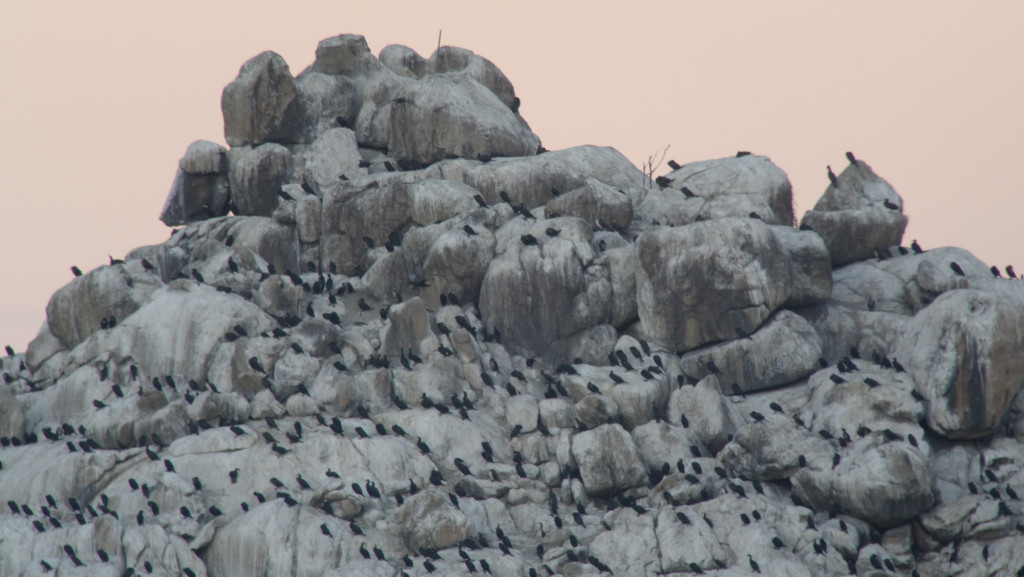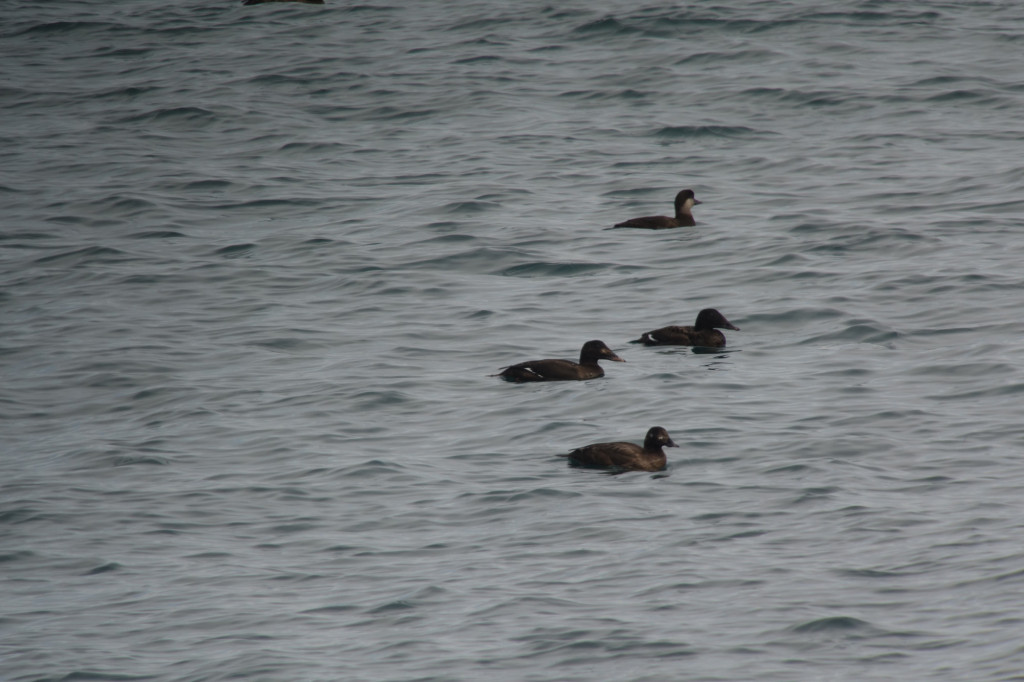Bird News by Jason Loghry with Park Seonyoung & Niall Ruddy
In summer of 2014, Nial Moores, Ha Jung Moon and I surveyed Seoraksan; each with a scope in hand. I hoped to do a repeat, but this time in winter. To replicate the survey, we started from Hangyerang Services. This became our first challenge as the trail was closed due to deep snow. We then re-routed to the nearby Osaek trail. It was supposedly an easier trail, and there was no snow or ice on the ground reported until about 900M. As we hiked up, there were a few mild flurries of snowflakes and Eurasian Nuthatch. There were Japanese Pygmy Woodpecker, Great Spotted Woodpecker, White-backed Woodpecker, Eastern Great Tit, Long-tailed Tit, Eurasian Bullfinch (1 heard), Goldcrest, and some very handsome Marsh Tits.
From above 1000M, we continued to encounter nuthatches, as well as Varied and Marsh Tit, and Eurasian Treecreeper. The Varied, Marsh, and Nuthatches seemed to be working on their own collections of nuts and other findings left behind by the hikers. In one section, they appeared to be more than curious, almost begging and approaching us closely. At above 1500M, there were still nuthatches and Marsh Tit, but no sign of accentors or rosy finches. At Daecheongbong, the wind was bitterly cold. The waste-high shrubbery and conifers were now seemingly bare, and there were no sign of birds besides a few Large-billed Crows, one nuthatch and one Marsh Tit, which were all near the shelter at Jungbong.
On our way from Jungbong to Socheongbong, a group of 15 Asian Rosy Finches flew overhead only to quickly disappear into the depths of a nearby valley. Close to sunset, a separate group of 4 Asian Rosies dropped in and perched in a tree nearby, but flew away too quickly for us to get a good view in the scope. As the sun fell west, a look across the mountains revealed several rocky snow-less peaks that were probably better habitat for accentor; but just too far in the cold distance to investigate. On our second day, morning temperatures fell to a frigid -16C near the peak. The wind was more powerful and even colder than the day before, so time spent searching for nutcracker, accentor, and rosy finch was limited. On the way down, most of the same species were observed. If I were to hike this trail again during winter, I would only bring binoculars and a few of the other essentials. I would also recommend reserving a spot at the shelter to allow for an easier hike. If you are staying at the shelter, it would probably good to bring earplugs as well.
Part two of our trip began with a drive to Hwajinpo for a cozy night’s sleep at January Pension. On the way, we stopped at several beaches picking through large flocks of gulls – with mostly Slaty-backed Gull mixed with Common and Vega Gull. Many of these large flocks seemed to be feeding in a frenzy at times near the beach. We also passed 4 Glaucous Gull, 7 Black-legged Kittiwake, and 13 Harlequin Duck at different locations on the way up. Almost to Hwajingpo, we came to a beach with a large rock in the distance, set against the horizon of the sea. A closer look revealed several hundred roosting Cormorant. It was quite a sight. What else could be found there in the right conditions?
The next morning, it was wonderful to wake up and be able to look across the sea and see Red-breasted Merganser, Common Goldeneye, Black-necked Grebe, Pacific Loon, Arctic Loon, Pelagic Cormorant, Spot-billed Duck and Mallards, and many of the same gull species seen on the previous day. We were excited to also find our trip’s first Glaucous-winged Gull. Leaving Hwajinpo, we spotted a White-tailed Eagle near the lake, Hawfinch, Dusky Thrush, and several Rustic Bunting in some of the forested areas, and then came across a beach with 400+ Great Crested Grebe just beyond a barbed-wire fence, and another large gull flock feeding (devouring) some kind of seed or seaweed or maybe egg (?); images below. It was very interesting to watch. The highlight of the trip was coming across a beach which allowed for great views of scoter – both American and White-winged Scoter. This was the first time we were able to get really good looks at White-winged Scoter. It was easy to agree on how stunning the male is! We spent quite some time watching them. The trip ended abruptly with car troubles while on our way to Odaesan for the evening. The only other interesting part of the trip happened while we were waiting for the car to be repaired. As we sat at the beach watching Common Mergansers at sea, three Northern Lapwings passed overhead. They were the least likely species we imagined to see near the beach.
 Morning moonlight from Socheongbong, Seoraksan
Morning moonlight from Socheongbong, Seoraksan
 Spotted Nutcracker breeding habitat in winter, Seoraksan
Spotted Nutcracker breeding habitat in winter, Seoraksan
 Eurasian Nuthatch Sitta europaea
Eurasian Nuthatch Sitta europaea
 Eurasian Treecreeper Certhia familiaris
Eurasian Treecreeper Certhia familiaris
 White-backed Woodpecker Dendrocopos leucotos
White-backed Woodpecker Dendrocopos leucotos
-Part Two-
 Gulls in a feeding frenzy, northeast coast
Gulls in a feeding frenzy, northeast coast
 Common scenery along the north-eastern coast (also site of 400+ Great Crested Grebes)
Common scenery along the north-eastern coast (also site of 400+ Great Crested Grebes)
 An even closer look; which cormorant species do you see?
An even closer look; which cormorant species do you see?
 3rd Winter (?) Glaucous-winged Gull Larus glaucescens
3rd Winter (?) Glaucous-winged Gull Larus glaucescens
 Another flock of gulls in feeding frenzy
Another flock of gulls in feeding frenzy
 What they were eating; any ideas of what it might be?
What they were eating; any ideas of what it might be?
 Adult male Asiatic White-winged Scoter Melanitta (deglandi) stejnegeri
Adult male Asiatic White-winged Scoter Melanitta (deglandi) stejnegeri
 Ten American Scoter (including two females) and a female White-winged Scoter (bottom right)
Ten American Scoter (including two females) and a female White-winged Scoter (bottom right)
 three White-winged Scoter, one American Scoter (rear)
three White-winged Scoter, one American Scoter (rear)
All images © Jason Loghry/Birds Korea







Ding-ding-ding! We have a winner: Ms. Seo Haemin. Thank you! She says they are the eggs of Arctoscopus japonicus, which see saw for her first time at Gangneung, also this December. Here is a link she shared: https://ko.m.wikipedia.org/wiki/도루묵
I missed this from an earlier bird news report from Nial Moores:
“Vega Gull 재갈매기. Huge numbers were present, especially on the 18th and 19th, with at least 3,000 in one flock on the latter date. Most were feeding on what appeared to fish eggs or fish egg-cases (of dorumu?).”
https://www.birdskoreablog.org/?p=17368